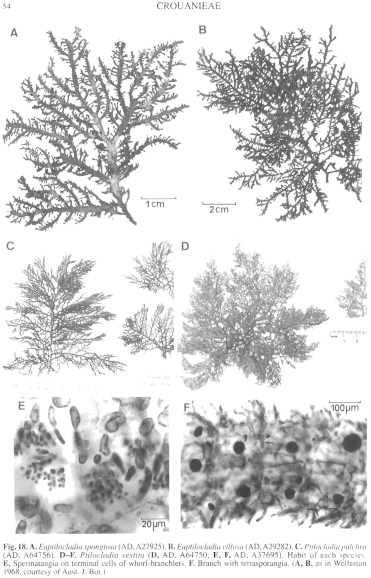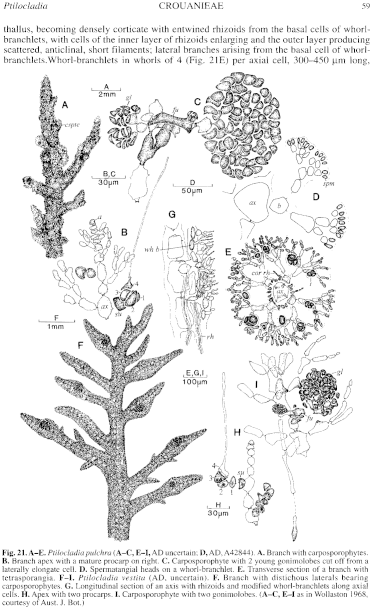|
|
|
|
|
|||||||||||
|
Electronic Flora of South Australia Species Fact Sheet
Phylum Rhodophyta – Order Ceramiales – Family Ceramiaceae – Tribe Crouanieae
Selected citations: Huisman et al. 1990: 96. Huisman & Walker 1990: 425. Kendrick et al. 1990: 52. Silva et al. 1996: 423.
Synonym
Crouania vestita Harvey 1855a: 558; 1860: pl. 140; 1863, synop.: xlix. J. Agardh 1876: 86; 1879: pl. II figs 8, 9. De Toni 1903: 1419. De Toni & Forti 1923: 56. Guiler 1952: 98. Lucas 1909: 51. Lucas & Perrin 1947: 356, fig. 177. May 1965: 366. Mazza 1912: No. 416. Sonder 1881: 12. Womersley 1948: 162; 1950: 179.
Thallus (Figs 18D, 21F) medium grey-red, 2–8 (–10) cm high, spongiose, branches terete, irregularly to more or less alternately distichously branched, branches completely covered with whorl-branchlets except near active apices; axes and lower branches 1–2 mm in diameter, tapering to 150–300m near apices. Holdfast small, rhizoidal, 1–2 mm across; epiphytic on Posidonia, Amphibolis and various algae. Structure. Axes with short apical cells, enlarging to 20–25 µm in diameter and L/D 1–1.5 within a few cells, and increasing to 250–400 µm in diameter and L/D 2–2.5 in lower thallus, becoming corticate below (Fig. 21G) with rhizoids from the basal cell of whorl-branchlets, with anticlinal filaments from the rhizoid cells in older parts. Whorl-branchlets in whorls of 4, 150–500 µm long, directed obliquely upwards, branched several times, basal cells 25–35 µm in diameter and L/D 2–2.5, tapering to short chains of terminal cells 7–10 µm in diameter and L/D 1.5–3; pyriform gland cells common on the whorl-branchlets; lateral branches arising from the basal cell of whorl-branchlets. Cells uninucleate; rhodoplasts elongate in smaller cells to ribbon like and anastomosing in larger cells.
Reproduction: Gametophytes dioecious. Procarps (Fig. 21H) replacing whorl-branchlets near branch apices, with a supporting cell bearing a 4-celled carpogonial branch. Post-fertilization the auxiliary cell cuts off an upper cell which produces a rounded gonimolobe 200–500 µm across, with ovoid carposporangia 25–40 µm across, followed by later gonimolobes (Fig. 21F, I); the carposporophyte (Fig. 21F, I) lies on elongate branches, surrounded by adjacent whorl-branchlets. Spermatangia (Fig. 18E) are cut off from terminal cells of whorl-branchlets, ovoid, 3–4 µm in diameter.
Tetrasporangia (Fig. 18F) occur on lower cells of whorl-branchlets, sessile, subspherical, 45–65 in diameter, tetrahedrally divided.
Type from Rottnest I., W. Aust., on "Zostera" (Posidonia) (Harvey); lectotype in Herb. Harvey, TCD (Tray. Set 338).
Selected specimens: Tantabiddy Creek, Exmouth, W. Aust., low eulittoral pools (Cambridge, 21. viii.1979; AD, A51802). Point Peron, W. Aust., drift (Parsons, 15.xi.968; AD, A34323). King George Sound, W. Aust. (Harvey, Alg. Aust. Exsicc. 486B; AD, A18282). Eucla, W. Aust., drift (Parsons, 5.xi.1968; AD, A33956). Anxious Bay, S. Aust., on Metagoniolithon, drift (Parsons, 24.viii.1967; AD, A31938). Elliston, S. Aust., 11 m deep in bay (Shepherd, 27.x.1971; AD, A42687). Barker Rocks, Yorke Pen., S. Aust., on Posidonia, drift (Womersley, 24.ix.1967; AD, A31958). Tiparra Reef, S. Aust., on Amphibolis, 11 m deep (Shepherd, 31.x.1970; AD, A37695 and 13.xii.1971; AD, 41223). Port Willunga, S. Aust., on Haliptilon, drift (Gordon, 12.x.1964; AD, A28322). Victor Harbor, S. Aust., drift (Womersley, 17.x.1948; AD, A9220). Seal Bay, Kangaroo I., S. Aust., on Metagoniolithon, drift (Womersley, 22.xi.1968; AD, A32984). D'Estrees Bay, Kangaroo I., S. Aust., on Sargassum, drift (Womersley, 23.viii.1963; AD, A27034). Nora Creina, S. Aust., drift (Womersley, 6.xii.1995; AD, A64750). Stinky Bay, Nora Creina, S. Aust., drift (Wollaston, 7.xi.1965; AD, A29643). Port MacDonnell, S. Aust., drift (Womersley, 27.x.1966; AD, A66728). Glenelg R. mouth, Vic., drift (Beauglehole, 22.i.1950; AD, A15586). Rocky Cape, Tas., drift (Gordon, 18.i.1966; AD, A29966).
Distribution: Exmouth, W. Aust., to Glenelg R. mouth, Vic., and N Tasmania.
Taxonomic notes: P. vestita appears to be usually epiphytic, especially on coralline algae often themselves on seagrasses or robust algae. It differs from P. pulchra in details of the rhizoidal cortication, in usually having abundant gland cells on the whorl-branchlets, and in the position of the carposporophytes.
References:
AGARDH, J.G. (1876). Species Genera et Ordines Algarum. Vol. 3, Part 1- Epicrisis systematic Floridearum, pp. i-vii, 1–724. (Weigel: Leipzig.)
AGARDH, J.G. (1879). Florideernes morphologi. K. Svenska Vetensk. Akad. Handl. 15(6), 1–199, Plates 1–33.
DE TONI, G.B. & FORTI, A. (1923). Alghe di Australia, Tasmania e Nouva Zelanda. Mein. R. Inst. Veneto Sci., Lett. Arti 29, 1–183, Plates 1–10.
DE TONI, G.B. (1903). Sylloge Algarum omnium hucusque Cognitarum. Vol. 4. Florideae. Sect. 3, pp. 775–1521 + 1523–1525. (Padua.)
GUILER, E.R. (1952). The marine algae of Tasmania. Checklist with localities. Pap. Proc. R. Soc. Tasmania 86, 71–106.
HARVEY, W.H. (1855a). Some account of the marine botany of the colony of Western Australia. Trans. R. Jr. Acad. 22, 525–566.
HARVEY, W.H. (1860). Phycologia Australica. Vol. 3, Plates 121–180. (Reeve: London.)
HARVEY, W.H. (1863). Phycologia Australica. Vol. 5, Plates 241–300, synop., pp. i-lxxiii. (Reeve: London.)
HUISMAN, J.M. & WALKER, D.I. (1990). A catalogue of the marine plants of Rottnest Island, Western Australia, with notes on their distribution and biogeography. Kingia 1, 349–459.
HUISMAN, J.M., KENDRICK, G.A., WALKER, D.I. & COUTÉ, A. (1990). The Marine Algae of Shark Bay, Western Australia. Research in Shark Bay. Report of the France-Australe Bicentenary Expedition Committee, pp. 89–100.
KENDRICK, G.A., HUISMAN, J.M. & WALKER, D.I. (1990). Benthic macroalgae of Shark Bay, Western Australia. Bot. Mar 33, 47–54.
LUCAS, A.H.S. & PERRIN, F. (1947). The Seaweeds of South Australia. Part 2. The Red Seaweeds. (Govt Printer: Adelaide.)
LUCAS, A.H.S. (1909). Revised list of the Fucoideae and Florideae of Australia. Proc. Linn. Soc. N.S.W. 34, 9–60.
MAY, V. (1965). A census and key to the species of Rhodophyceae (red algae) recorded from Australia. Contr. N.S.W. natn. Herb. 3, 349–429.
MAZZA, A. (1912). Saggio di Algologia Oceanica. Nuova Notarisia 23, Nos. 415–447.
SILVA, P.C., BASSON, P.W. & MOE, R.L. (1996). Catalogue of the Benthic Marine Algae of the Indian Ocean. (University of California Press: Berkeley, Los Angeles & London.)
SONDER, O.W. (1881). In Mueller, F., Fragmenta Phytographiae Australiae. Supplementum ad volumen undecinum: Algae Australianae hactenus cognitae, pp. 1–42, 105–107. (Melbourne.)
WOLLASTON, E.M. (1968).Morphology and taxonomy of southern Australian genera of Crouanieae Schmitz (Ceramiaceae, Rhodophyta). Aust. J. Bot. 16, 217–417.
WOMERSLEY, H.B.S. (1948). The marine algae of Kangaroo Island. II. The Pennington Bay Region. Trans. R. Soc. S. Aust. 72, 143–166, Plates 10–15.
WOMERSLEY, H.B.S. (1950). The marine algae of Kangaroo Island. III. List of Species 1. Trans. R. Soc. S. Aust. 73, 137–197.
The Marine Benthic Flora of Southern Australia Part IIIC complete list of references.
Publication:
Womersley, H.B.S. (24 December, 1998)
The Marine Benthic Flora of Southern Australia
Rhodophyta. Part IIIC. Ceramiales – Ceramiaceae, Dasyaceae
©State Herbarium of South Australia, Government of South Australia
Illustrations in Womersley Part IIIA, 1998: FIGS 18 D–F, 21 F–I.

Figure 18 enlarge
Fig. 18. A. Euptilocladia spongiosa (AD, A27925). B. Euptilocladia villosa (AD, A29282). C. Ptilocladia pulchra (AD, A64756). D–F. Ptilocladia vestita (D, AD, A64750; E, F, AD, A37695). Habit of each species. E. Spennatangia on terminal cells of whorl-branchlets. F. Branch with tetrasporangia. (A, B, as in Wollaston 1968, courtesy of Aust. J. Bot.)

Figure 21 enlarge
Fig. 21. A–E. Ptilocladia pulchra (A–C, E–I, AD uncertain; D, AD, A42844). A. Branch with carposporophytes. B. Branch apex with a mature procarp on right. C. Carposporophyte with 2 young gonimolobes cut off from a laterally elongate cell. D. Spermatangial heads on a whorl-branchlet. E. Transverse section of a branch with tetrasporangia. F–I. Ptilocladia vestita (AD, uncertain). F. Branch with distichous laterals bearing carposporophytes. G. Longitudinal section of an axis with rhizoids and modified whorl-branchlets along axial cells. H. Apex with two procarps. I. Carposporophyte with two gonimolobes. (A–C, E–I as in Wollaston 1968, courtesy of Aust. J. Bot.)

|
Email Contact: State Herbarium of South Australia |

|